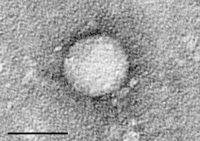
Photo from wikipedia
With over 40 years of history, occult hepatitis B infection (OBI) continues to remain an important and challenging public health problem. Defined as the presence of replication-competent hepatitis B virus… Click to show full abstract
With over 40 years of history, occult hepatitis B infection (OBI) continues to remain an important and challenging public health problem. Defined as the presence of replication-competent hepatitis B virus (HBV) DNA (i.e., episomal HBV covalently closed circular DNA) in the liver and/or HBV DNA in the blood of people who test negative for hepatitis B surface antigen (HBsAg) in currently available assays, OBI is currently diagnosed using polymerase chain reaction (PCR) and real-time PCR assays. However, all efforts should be made to exclude a false negative HBsAg in order to completely follow the definition of OBI. In recent years, significant advances have been made in understanding the HBV lifecycle and the molecular mechanisms that lead to the persistence of the virus in the occult form. These factors are mainly related to the host immune system and, to a smaller proportion, to the virus. Both innate and adaptive immune responses are important in HBV infection management, and epigenetic changes driven by host mechanisms (acetylation, methylation, and microRNA implication) are added to such actions. Although greater genetic variability in the S gene of HBV isolated from OBIs was found compared with overt infection, the mechanisms of OBI are not mainly viral mutations.
Journal Title: World Journal of Clinical Cases
Year Published: 2022
Link to full text (if available)
Share on Social Media: Sign Up to like & get
recommendations!